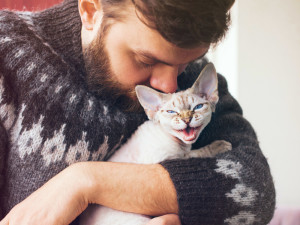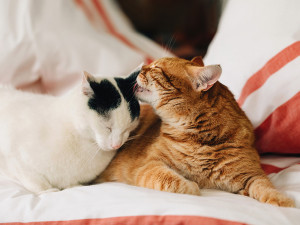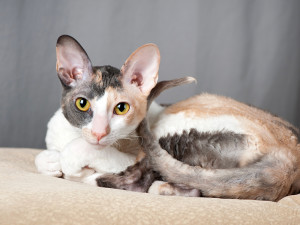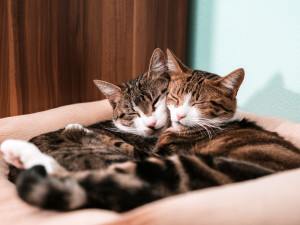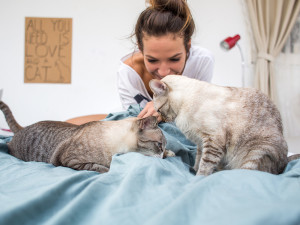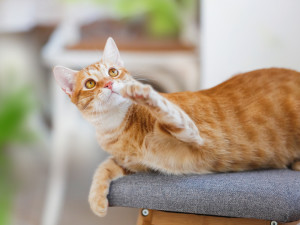Why Does Your Cat Only Like You?
It’s nice being the favorite, though.

Share Article
In This Article:
Why Does My Cat Only Like Me? Why Does My Cat Hate Other People? Why Do Cats Attach Themselves To One Person?
Your cat is your special baby, but sometimes, it seems like you are the only one they care about. They will snuggle you, but your partner? Forget it. Friends who come over for dinner? Nah. They aren’t a fan. Rude. Why does this happen, and what can you do about it?
Why does my cat only like me?
Trust me, you’re not the only one who thinks their cat hates everyone but them. They may hide from other people. You may think your cat is mean, responding to others’ advances with a hiss or swat.
It’s common for cats to attach to one person and seemingly “hate” anyone else. But we have to be careful about attaching human emotions to our kitties. Cats and humans have many similarities. There are also many differences, especially in the way we experience, analyze, and react to people and situations. Let’s talk about what your cat’s preference for you and dislike of other people might really mean, from their perspective.

Why does my cat hate other people?
Anthropomorphizing means that we’re attaching human characteristics and behavior to (in this case) cats. And that can get us into trouble. We often misread signals from our cats because we’re using the lens of human logic instead of cat logic.
For example, you’ve heard the idea that cats pee outside the litter box out of spite. Think about the emotional process it takes to be spiteful. Your cat would have to decide they’re mad at you and want to cause you distress, think about what they could do that would upset you, then do it just so you’d feel bad. That’s way beyond cats’ capabilities. Their motives are much simpler and to-the-point. What looked vengeful and negative was probably just a cat feeling anxious and needing support.
With this in mind, what do you think about cats being capable of (or interested in) hate? To me, that feels a bit too “human.” What we read as hate is probably a more instinctual reaction, like:
Fear or anxiety around others
It’s common for cats to feel fear or anxiety, especially in unfamiliar situations or when they don’t think they have any control.
If your cat hasn’t had much positive exposure to other people, their natural reaction may be to hide or use defensive aggression to keep everyone at a safe distance. Lots of things can trigger this reaction, even a person’s scent or how loudly they speak.
Naturally cautious
Cats may hunt in the wild, but they’re also the target of other predators. When you can be eaten by other critters, you’re instinctually a bit cautious. Some cats are more cautious than others. They’d rather assume danger and go into fight-or-flight mode right away rather than risk waiting until it’s too late. These cats may be less friendly to people they don’t know well and feel safe with.
Individual preference
Cats have preferences, just like us. Your cat may prefer your quiet nature to your livelier roommate, or your way of petting over your young nieces. It’s simply about what feels more comfortable and enjoyable for them. You may understand and respect those preferences more than other people, leading your cat to prefer your company.
Why do cats attach themselves to one person?
There are lots of reasons your cat may have attached themselves specifically to you. They may even have a few people they’ve bonded with, while not wanting to bond so much with others.
Early bonding and socialization
Cats are formed by their early experiences. If your cat didn’t have much exposure to anyone else in their first year or two of life, they may naturally be leery of other people. This has been the case with many cats adopted during the COVID lockdown. There weren’t many people visiting and many of us were working from home, limiting our cats’ experiences with guests and being alone.
If they had exposure to others, but it wasn’t positive, you can get the same result. For example, if someone in the home yelled loudly and scared your cat when they got on the table, a negative association could have been formed. They learned that other people can be scary.
The good news is that it’s never too late to slowly and positively help your cat get comfortable with things that make them nervous, even people.
Primary caregiver
It’s only natural for a cat to feel a connection with the person who feeds them, has daily play sessions, or just makes time for cuddles. The primary care giver is important for survival and emotional wellbeing.
Understanding their language
Cats are brilliant communicators, but only if you learn to speak their language (or should I say, their body language). It’s not easy for everyone to understand that a subtle turn of the ears can mean they’ve had enough petting and would like you to stop, or the tail going from a leisurely swish to an agitated swish can mean they’re starting to get upset. Those missed cues can lead to a negative interaction between the cat and person.
If your cat has “chosen” you as theirs, you probably do a really good job at catching and respecting those cues, making your cat more comfortable with you than others.
Quality time
There are so many wonderful things to do with a cat: tossing furry mice, cuddling, watching birds together, etc. If you’re the one who enjoys spending time with a cat and doing things they love, there’s going to be a connection between the two of you.
Personality preferences
Again, cats are individuals. They have their own preferences, even when it comes to personality — but probably not the way you think. It’s more about how the movements and demeanors of other people them feel — safe, comforted, energized, afraid their tail may get stepped on, etc.
A person with a boisterous laugh, or someone who talks fast and moves faster, may be unsettling for a nervous cat who prefers quiet environments, slow movements, and soft footsteps. On the other hand, a high-energy cat may love the kids running around the house with their playful personalities.
What you can do and when to seek expert help
We’ve talked about many reasons your cat may prefer you over other people. If that’s just a personal preference, no one minds, it’s fine to let them have a favorite person. On the other hand, if that other person wants to improve their relationship, or your cat seems genuinely afraid, you can help.
There are positive training and desensitization techniques you can use to help cats get comfortable with things they may find scary or unpleasant. Working with a certified feline training and behavior consultant is a great way to do this. They can look for possible triggers (reasons your cat has issues with other people) and give you a plan to change those relationships for the better.
You can also do simple things, like:
Make good things happen for your cat when other people are around. Don’t force any interactions. Your cat should stay where they feel comfortable. Even if they’re hiding under the bed, you can take a minute here and there to pop in and do something positive. Give treats, pets, have a quick play session, etc. This teaches your cat, “Hey, every time other people show up, I get really good stuff! I like it when other people show up!”
Reward brave behavior. If your cat is nervous to come out around strangers, but they eventually peek around the corner before running back under the bed, reward it. If they get up the courage to come into the room, even if they still choose to keep their distance, reward it. If they move closer to someone, (you guessed it) reward it! Again, good things happen for your cat when they choose to be brave around people.
Reward any positive interactions with other people, no matter how small. If your cat walks up, sniffs their pants, then walks away, reward that sniff! If they allow a pet or choose to sit near someone, reward it. Those rewards can be anything they love. Treats, pets, verbal praise, tossing a toy, etc.
If your cat has extreme fear or anxiety with other people — whether it’s only when they get too close or as soon as they ring the doorbell — it’s a good idea to talk with a professional. This fear could be impacting your cat’s quality of life.
Your veterinarian can make sure there’s nothing medical going on that may increase your cat’s stress. You can also discuss anxiety medication, natural calming supplements, and other medical ways to help your cat relax. A certified feline training and behavior consultant can help with the emotional side of things, like looking for and addressing any triggers that might be causing fear, reducing stress, building confidence and more.
There are many ways to help cats feel comfortable with more than just their chosen human. And, hey, if they love you best, that’s kind of great in its own way.
References
Anderson, Jocelyn C. “6 Common Cat Behaviors Explained.” UC Davis, 19 Apr. 2021, www.ucdavis.edu/magazine/6-common-cat-behaviors-explainedopens in new tab. Accessed 6 Feb. 2025.
Baillie, Katherine. “Demystifying Feline Behavior.” Penn Today, 19 Feb. 2020, penntoday.upenn.edu/news/demystifying-feline-behavioropens in new tab.
Cornell Feline Health Center. “Feline Behavior Problems: Aggression.” Cornell University College of Veterinary Medicine, 9 Oct. 2017, www.vet.cornell.edu/departments-centers-and-institutes/cornell-feline-health-center/health-information/feline-health-topics/feline-behavior-problems-aggressionopens in new tab.
Ines, Mauro, et al. “My Cat and Me—a Study of Cat Owner Perceptions of Their Bond and Relationship.” Animals, vol. 11, no. 6, 29 May 2021, p. 1601, https://doi.org/10.3390/ani11061601opens in new tab. Accessed 2 Aug. 2021.
Lee, Justine. “Understanding Anxiety in Cats: Helping Cats Cope with Environmental Change | VETgirl Veterinary Continuing Education Blog.” VETgirl, 9 July 2021, vetgirlontherun.com/understanding-anxiety-in-cats-helping-cats-cope-with-environmental-change-vetgirl-veterinary-continuing-education-blog/opens in new tab.
“Separation Anxiety | Indoor Pet Initiative.” Osu.edu, 2025, indoorpet.osu.edu/cats/problem-solving/separation-anxietyopens in new tab. Accessed 6 Feb. 2025.

LeeAnna Buis, CFTBS, FFCP
LeeAnna Buis has adored cats her entire life and thought she knew them inside out and sideways. But it wasn’t until she worked with a feline behavior consultant that she fully understood how incredible, complicated, and inspiring they really are. She made a career change, starting the certification process to become a behavior consultant right away. She discovered what unique, fascinating, complex creatures cats are and knew this was what she wanted to do with her life — help others on a similar journey to truly knowing, loving, and appreciating their cats.
LeeAnna earned her certification through Animal Behavior Institute, where she received the certified feline training and behavior specialist (CFTBS) designation.
Related articles
![An angry and hissing Siamese kitten standing on top of a laptop computer in the living room]()
You Don’t Have to Live Like This—You Can Get a Trainer For Your Cat
Tips to help you find a legit behaviorist (according to a veterinary behaviorist).
![Two tabby cats cuddling each other with their eyes closed]()
Cats Aren’t Loners, After All
Cat behaviorist Kristiina Wilson on the importance of socializing cats.
![Cornish Rex cat laying down on a pillow]()
The Cat Breed-Behavior Connection
Which cats are more likely to have stranger danger? Bite the hand that feeds them? Do the zoomies? Scientists studied 5,700 pet cats and discovered some interesting traits.
![Two tabby cats in embrace lying in cushion.]()
What Are Cat Pheromones and How Do They Work?
Communication is key, and pheromones are your cat’s version of DMs.
Do Cats Get Jealous? Exploring Feline Emotions and Social Dynamics
Is there a green-eyed monster hiding in that adorable ball of fluff?
![orange cat lifting its paw]()
Why Do Cats Raise a Paw for No Reason?
Are they saying “Hi” or trying to high five? Cat behaviorists decode your pet’s cryptic hand signal.


